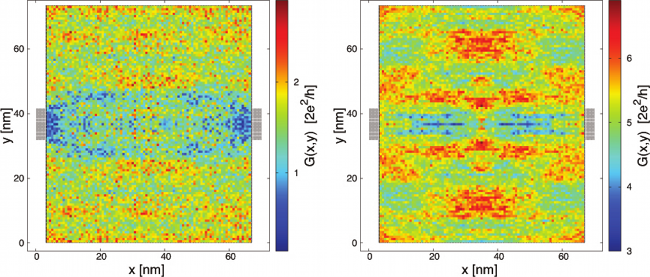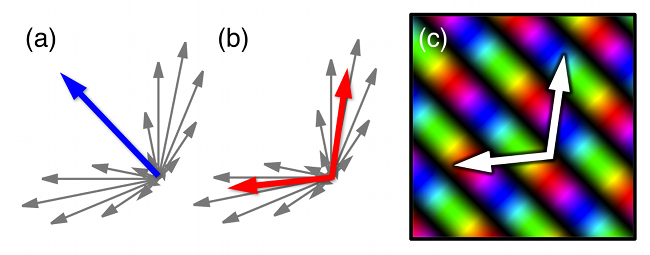Light-Matter Interactions | Quantum Transport | Quantum Information | Semiclassics | Interference | Ultra-Cold Atoms | Renewable Energy
Light-Matter Interactions
Most of the research performed by our group revolves about matter interacting with electromagnetic waves: BECs with lasers, electrons in quantum dots manipulated by laser fields or voltage probes, voltage probes used in elucidating electron dynamics in graphene, ... etc.
Yet, we also perform research in which the properties of matter can be probed by light. Recent work include photo-induced oxidation of phosphorene in collaboration with Prof. Barraza-Lopez (University of Arkansas), studying the optical properties of eumelanin-inspired molecules with the experimental group of Prof. Nelson (OSU Chemistry), and with Prof. Heller (Harvard University) developing an alternative theory of Raman Spectroscopy for Graphene.
Quantum Transport
 We use analytical and computational techniques to study charge and spin transport in semiconductor and graphene devices. Some examples include the anomalous Hall effect in strongly spin-coupled semiconductors, the Aharonov-Casher effect in semiconductor rings, and imaging universal conductance fluctuations in graphene.
As an example, the above figures are simulations of Scanning Probe Microscopy in graphene nanostructures. Here, in collaborations with Dr. Hennig (Max Planck) and Prof. Heller (Harvard University), we study the flow of electrons in clean devices to ascertain if they are truly ballistic.
We use analytical and computational techniques to study charge and spin transport in semiconductor and graphene devices. Some examples include the anomalous Hall effect in strongly spin-coupled semiconductors, the Aharonov-Casher effect in semiconductor rings, and imaging universal conductance fluctuations in graphene.
As an example, the above figures are simulations of Scanning Probe Microscopy in graphene nanostructures. Here, in collaborations with Dr. Hennig (Max Planck) and Prof. Heller (Harvard University), we study the flow of electrons in clean devices to ascertain if they are truly ballistic.
Quantum Information
 Our group is pioneering the use of Quantum Optimal Control Theory in solid-sate semiconductor systems. In collaboration with Dr. Blasi, Prof. Rasanen (Tampere University, Finland), and Prof. Heller (Harvard University) we found how to minimize the time it takes to coherently control many-body states using laser pulses and how to control charge density in nanostructures using local gates (image above).
Our group is pioneering the use of Quantum Optimal Control Theory in solid-sate semiconductor systems. In collaboration with Dr. Blasi, Prof. Rasanen (Tampere University, Finland), and Prof. Heller (Harvard University) we found how to minimize the time it takes to coherently control many-body states using laser pulses and how to control charge density in nanostructures using local gates (image above).
Semiclassics
 We develop techniques to study the features of quantum dynamics that bear witness of their underlying classical structure. Although semiclassical visualizations (such as the Husimi distribution and also Wigner's quasi-probability distribution function) have been produced before, in collaboration with Dr. Mason (Twitter) and Prof. Heller (Harvard University) we developed the notion of processed Husimi flows. This approach is optimal for studying the dynamics of certain systems; producing clearer pictures than those obtained from the traditional flux operator. For instance, the wavefunction above (c) is for an electron in a magnetic field. A set of coherent state projections is shown in grey (a-b). The flux (a) averages over all such projections giving a total flow (blue arrow) that does not reflect the dynamics of the system. However, in (b) we see that the processed Husimi flow (red arrows) does reconstruct the flow structure present in the wavefunction.
We develop techniques to study the features of quantum dynamics that bear witness of their underlying classical structure. Although semiclassical visualizations (such as the Husimi distribution and also Wigner's quasi-probability distribution function) have been produced before, in collaboration with Dr. Mason (Twitter) and Prof. Heller (Harvard University) we developed the notion of processed Husimi flows. This approach is optimal for studying the dynamics of certain systems; producing clearer pictures than those obtained from the traditional flux operator. For instance, the wavefunction above (c) is for an electron in a magnetic field. A set of coherent state projections is shown in grey (a-b). The flux (a) averages over all such projections giving a total flow (blue arrow) that does not reflect the dynamics of the system. However, in (b) we see that the processed Husimi flow (red arrows) does reconstruct the flow structure present in the wavefunction.
Interference Phenomena
 Our group studies quantum interference as it manifests itself in mesoscopic systems via transport measurements. The ring nanostructure presented above is ideal to see interference of the electrons (or holes) traveling in each of the arms. Along with a magnetic field, the device can also have a gate voltage induced spin-orbit interaction resulting in richer interference patterns.
Our group studies quantum interference as it manifests itself in mesoscopic systems via transport measurements. The ring nanostructure presented above is ideal to see interference of the electrons (or holes) traveling in each of the arms. Along with a magnetic field, the device can also have a gate voltage induced spin-orbit interaction resulting in richer interference patterns.
Ultra-Cold Atoms
 As a Ph.D. student in the group led by Prof. Jairo Sinova (now at Universitat Mainz, Germany) and in collaboration with Xiong-Jun Liu (now professor at ICQM PKU, China) and Xin Liu (now at Penn State), we proposed a scheme to induce and observe spin-orbit effects in atomic systems has been realized recently by three independent experiments. (see above). Now at Oklahoma, we are collaborating with the experimental BEC group directed by Professor Gil Summy. Stay tuned for some exciting research!
As a Ph.D. student in the group led by Prof. Jairo Sinova (now at Universitat Mainz, Germany) and in collaboration with Xiong-Jun Liu (now professor at ICQM PKU, China) and Xin Liu (now at Penn State), we proposed a scheme to induce and observe spin-orbit effects in atomic systems has been realized recently by three independent experiments. (see above). Now at Oklahoma, we are collaborating with the experimental BEC group directed by Professor Gil Summy. Stay tuned for some exciting research!
Renewable Energy
Our group has started searching for organic semiconductor materials that will be better photovoltaics, thermoelectrics, and might have spintronic capabilities.
